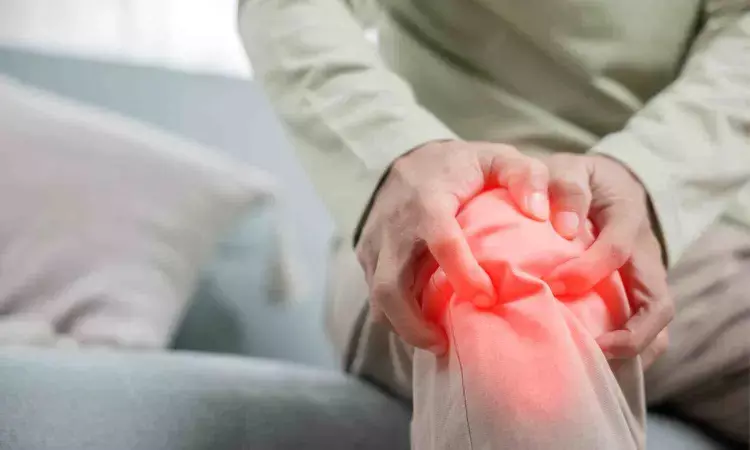- Home
- Medical news & Guidelines
- Anesthesiology
- Cardiology and CTVS
- Critical Care
- Dentistry
- Dermatology
- Diabetes and Endocrinology
- ENT
- Gastroenterology
- Medicine
- Nephrology
- Neurology
- Obstretics-Gynaecology
- Oncology
- Ophthalmology
- Orthopaedics
- Pediatrics-Neonatology
- Psychiatry
- Pulmonology
- Radiology
- Surgery
- Urology
- Laboratory Medicine
- Diet
- Nursing
- Paramedical
- Physiotherapy
- Health news
- Fact Check
- Bone Health Fact Check
- Brain Health Fact Check
- Cancer Related Fact Check
- Child Care Fact Check
- Dental and oral health fact check
- Diabetes and metabolic health fact check
- Diet and Nutrition Fact Check
- Eye and ENT Care Fact Check
- Fitness fact check
- Gut health fact check
- Heart health fact check
- Kidney health fact check
- Medical education fact check
- Men's health fact check
- Respiratory fact check
- Skin and hair care fact check
- Vaccine and Immunization fact check
- Women's health fact check
- AYUSH
- State News
- Andaman and Nicobar Islands
- Andhra Pradesh
- Arunachal Pradesh
- Assam
- Bihar
- Chandigarh
- Chattisgarh
- Dadra and Nagar Haveli
- Daman and Diu
- Delhi
- Goa
- Gujarat
- Haryana
- Himachal Pradesh
- Jammu & Kashmir
- Jharkhand
- Karnataka
- Kerala
- Ladakh
- Lakshadweep
- Madhya Pradesh
- Maharashtra
- Manipur
- Meghalaya
- Mizoram
- Nagaland
- Odisha
- Puducherry
- Punjab
- Rajasthan
- Sikkim
- Tamil Nadu
- Telangana
- Tripura
- Uttar Pradesh
- Uttrakhand
- West Bengal
- Medical Education
- Industry
Individuals with osteoarthritis commonly prescribed NSAIDs despite having contraindications: Study

Osteoarthritis affects 600 million people worldwide, making it a leading cause of disability. With no disease-modifying treatments available or on the horizon, oral non-steroidal anti-inflammatory drugs (NSAIDs) are commonly used treatments to relieve OA pain and are recommended by the majority of clinical practice guidelines. However, NSAIDs are not risk-free and are associated with more emergency hospital admissions than any other class of medicine due to their widespread use. The risk of adverse events further increases among older adults and those with comorbidities.
A new study from Boston University Chobanian & Avedisian School of Medicine, has
found that people with newly diagnosed OA (knee or hip) with contraindications to or precautions for NSAIDs use continue to be prescribed these drugs. Additionally they had higher use of opioids and slightly lower physical therapy (PT) use within the first year of OA diagnosis, both of which are not consistent with treatment guidelines for OA.
“We found individuals with contraindications to NSAIDs were still commonly prescribed them, placing them at risk for NSAID-related adverse events,” explains corresponding author Tuhina Neogi, MD, PhD, the Alan S. Cohen Professor of Rheumatology and professor of medicine at the school. “Additionally, they were not more likely to receive safer alternatives like PT despite its widespread recommendation as first-line intervention.”
The researchers used population-based register data to identify adults residing in Sweden (between 2004-13) without a previous knee or hip OA diagnosis. Among this group, between 2014-18, they identified people with knee or hip OA diagnosis and presence of contraindications to or precautions for oral NSAIDs at the time of OA diagnosis. They then estimated the risk of: 1) regular oral NSAID use; 2) regular opioid use; 3) PT during the first year after diagnosis among those with versus without contraindications or precautions.
Despite having contraindications to NSAIDs, 21% of those in the study were regular users of NSAIDs within the first year of their OA diagnosis. Similarly, 21% of those with precautions for using NSAIDs were also regular users. They also found a higher proportion of persons with contraindications were regular users of opioids than those without a contraindication or precaution, while a slightly lower proportion received PT.
According to the researchers, the lower use of PT use is particularly concerning given that PT and exercise are considered first-line therapy for knee and hip OA by many professional societies. “While PT use within the first year was relatively high in this cohort, likely reflecting the Swedish healthcare system (in which PT is a covered service with minor co-pay from the patient), it is concerning that in a system in which PT services are available and covered that those with NSAID contraindications are still less likely to undergo a PT visit,” added Neogi, who also is chief of rheumatology at Boston Medical Center.
Neogi stresses that more options for effective and safe management of OA symptoms are urgently needed, and greater work is required in narrowing and ultimately closing the evidence-knowledge-practice gap.
Reference:
Tuhina Neogi, Andrea Dell’isola, Martin Englund, Aleksandra Turkiewicz, Frequent Use of Prescription NSAIDs among People with Knee or Hip Osteoarthritis Despite Contraindications to or Precautions with NSAIDs, Osteoarthritis and Cartilage, https://doi.org/10.1016/j.joca.2024.07.010.
Dr Kamal Kant Kohli-MBBS, DTCD- a chest specialist with more than 30 years of practice and a flair for writing clinical articles, Dr Kamal Kant Kohli joined Medical Dialogues as a Chief Editor of Medical News. Besides writing articles, as an editor, he proofreads and verifies all the medical content published on Medical Dialogues including those coming from journals, studies,medical conferences,guidelines etc. Email: drkohli@medicaldialogues.in. Contact no. 011-43720751


